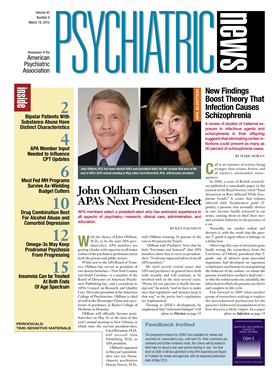APA is recommending that a wide range of billing codes used by psychiatrists be updated for improved reimbursement under the Medicare program as part of the federal government's latest review of Current Procedural Terminology (CPT) codes.
In a letter to the Centers for Medicare and Medicaid Services (CMS), APA Medical Director James H. Scully Jr., M.D.—along with leaders from four other mental health specialty societies—proposed that some 18 codes be reevaluated and updated. The other organizations are the American Academy of Child and Adolescent Psychiatry, American Association for Geriatric Psychiatry, American Nurses Association, and American Psychiatric Nurses Association.
The letter is in response to the federal government's call for a review of CPT codes, announced in the Federal Register on November 25, 2009.
The government's review of reimbursement codes is a rigorous process that calls for medical specialty societies to survey a representative sample of members for their evaluation of the “relative work values” associated with procedures performed by members of that specialty.
The survey process is coordinated by the AMA's Relative Value Scale Update Committee (RUC), which will then make recommendations to CMS for work and practice-expense values and other variables. Those values will be used by public and private payers to derive a reimbursement fee for each procedure.
The new values will go into effect for reimbursement beginning January 1, 2011.
Practice Has Changed Since Last Review
The last time psychiatric codes were reviewed was 1995, and the letter signed by Scully and colleagues noted that significant changes in practice have occurred since then.
“We believe that a number of codes used by psychiatrists and psychiatric/mental health advanced practice registered nurses (APRNs) are misvalued and should be reviewed, because the medical decision making required in treating psychiatric patients has increased materially since the last review,” they wrote.
Moreover, they pointed out that reimbursement for psychiatric services is generally poor and contributes to a shortage of psychiatrists treating Medicare patients. “Clearly, beyond all the standard compelling evidence that calls for a review of the values of these codes, [the shortage of psychiatrists] indicates a need to reevaluate payments for the very important services provided to Medicare beneficiaries by psychiatrists and APRNs.”
The codes proposed for review include those for an initial diagnostic interview examination, outpatient and inpatient psychotherapy, family therapy, and pharmacologic management.
Importantly for psychiatry, Scully and colleagues drew attention to discrepancies that exist between psychotherapy codes and equivalent evaluation and management (E&M) codes.
The latter are not timed codes—a “typical” time is noted in the CPT description, and an E&M service performed by a physician can be billed for regardless of the length of time spent—while psychotherapy codes require a specific amount of face-to-face time with the patient. Moreover, patients typically expect a psychotherapy session to last the maximum amount of time, while patients undergoing an E&M typically have no such expectations.
Scully and colleagues observed, however, that the E&M codes appear to be valued higher when comparing the typical times with the face-to-face time of the psychotherapy codes. This would seem to be especially in need of redress given the RUC's emphasis on “relativity” across medical procedures in assigning values, they said.
Additionally, they noted, in 1998 CMS created a new set of 24 codes that described psychotherapy, psychotherapy with E&M services, and interactive psychotherapy in a variety of settings for use by physicians and nonphysicians.
But as Scully and colleagues pointed out in their letter, the complexity of medical decision making—including the exponential growth in availability of new drugs—has increased dramatically so that the expertise involved on the part of psychiatrists using those psychotherapy codes is markedly different from that brought by nonmedical professionals.
“The values of the new codes were assigned on the basis of a survey that was meant to take into account the way psychiatry was practiced at that time,” they wrote. “When these codes were originally created, they minimized the medical functions that were included in their definitions based on assumptions about the nature of psychiatric practice that may well have been out of date even then.
“In the more than 10 years since their creation, as more empirical evidence has become available on the effectiveness of various treatment modalities and with the considerable increase in available medications, the practice of psychiatry and the treatment of patients in both inpatient and outpatient settings has become increasingly more complex and increasingly medical in nature.”
They added that patients seen by psychiatrists are typically those with refractory mental illness and medical comorbidities. “The knowledge base required of a psychiatrist or psychiatric/mental health APRN treating a patient with mental illness has continued to grow and develop since the last valuation of these codes,” they wrote.
“Many if not most patients do not show substantial response to any one given agent,” they continued. “New medications more specifically target individual disease-state symptoms, and they often have improved side-effect profiles, making combination treatment strategies more attractive. The legitimate increase in pressure to improve patient outcomes has changed the standard for successful treatment in psychiatry—the standard of care is now to achieve full control of symptoms and has been termed remission, or wellness, rather than just 50 percent improvement.”
